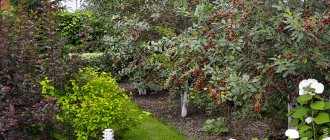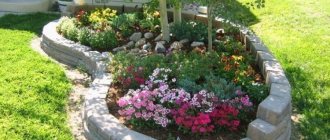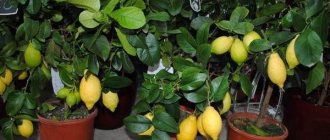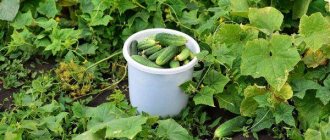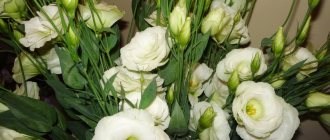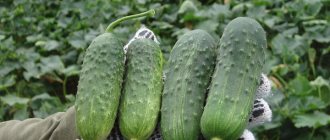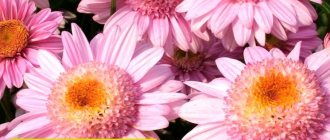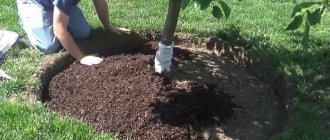0 590
When planning to design a flower bed along a path, many owners of a garden or country house do not know how to do it correctly. Very often, the large assortment of commercially available plants does not simplify, but creates difficulties with choice. Therefore, some resort to the services of landscape designers, while others take their advice.
Criteria for choosing trees and shrubs for landscape design
The selection of trees or shrubs for use in landscape design should be based on certain principles that guarantee the possibility of maximizing their use in the future.
The key criteria in this case will be:
- possible functionality of a particular instance;
- its compatibility with another plant or group of plants;
- dimensions of adult plants;
- direction of their growth.
Various types and varieties of elderberry are also used in landscape design.
Functions
The functionality of any bush-like or tree-like crop is its ability to beneficially complement a specific area of the garden or local area. So, for open areas you can use large bushes and trees, but for decorating a gazebo or pergola it is better to choose more compact varieties with a bizarre shape (it is possible to use shrubs with liana-like shoots). Evergreen thujas or individual spherical bushes are often planted along paths or on the border with neighbors.
Compatibility with other plants
An excessive number of trees or large spreading bushes will hide other decorative elements of the site from view, creating the impression of an impenetrable jungle. For this reason, if trees are already growing near the house, then it is better to supplement them with medium-sized shrubs that will harmoniously fit into the overall picture.
Important! When choosing a pair for a particular tree or bush, it is worth considering possible seasonal changes in these plants. It is very desirable that when planting in groups, the life rhythms of the crops used at least partially coincide
It is possible to build an ensemble of plants based on the principle of contrast, when varieties with different sets of characteristics visually interact with each other. Contrast can capture several characteristics at once (for example, bush shape, leaf size, color or shape of inflorescences), or focus on only one of these criteria.
The combination of plants always has a semantic meaning, based on the shape of their crown and leaves, as well as the abundance and brightness of flowering. For example, thuja and spirea, buzulnik and ornamental cereals will contrast favorably with each other.
Dimensions
The size of the crops chosen for landscaping also plays an important role in landscape design. In small areas, the main emphasis can be placed on bushes, and in large areas, a variety of group plantings of trees can be used.
It is better to start filling the designed volume with vegetation from the largest available specimens, gradually adding medium and small ones to them. It is much more difficult to act in the reverse order, not to mention the fact that such a decision will be devoid of any logic.
Find out which varieties of fir trees are best suited for landscape design.
The most balanced composition will be achieved if, as the importance of the structural element decreases, the number of specimens increases, that is, when planting in groups there should be more small bushes than large trees.
Growth direction
If the crown of most ornamental trees is spherical or vertical, then shrubs can have almost horizontal shoots. Dividing the bushes into groups depending on the direction of growth of the branches also helps to select the most advantageous pairs for them from among other plants.
Vertical bushes resemble trees, as they have a well-defined trunk and a clearly defined crown (for example, hawthorn). It is better to plant them next to lower, spherical “relatives”, since in combination with trees they can visually “drown out” each other.
The width of the crown of horizontal shrubs is much greater than the height of their trunk; the branches are located almost horizontally relative to the soil line. A classic example of this group can be considered horizontal juniper, which, unlike vertical bushes, perfectly complements tree-like plants.
We recommend reading: Dwarf pines in landscape design
The term “spherical bushes” can be used to combine all varieties of shrubs with a rounded crown, such as lilac or viburnum.
They combine well with the previous two types, although in this case a lot depends on the location of a particular culture.
Using trees and bushes with different directions of shoot growth, you can profitably arrange the space of your personal plot, creating real artistic masterpieces from seemingly ordinary crops.
Bloodroot
The charming cinquefoil is ideal for garden design.
The plant blooms throughout the warm season. It is unpretentious and survives even on infertile soil. There are several types of cinquefoil, which can be a ground cover plant or a shrub. The shades of the leaves and their size also depend on the variety. The flowers are white and light orange. They have a tender and fluffy center, golden due to the many stamens.
Cinquefoil is usually not affected by pests. It is ideal for an alpine slide or rock garden. Sunlight will benefit this plant. And being surrounded by stones will make its appearance even more exotic.
Height and habitus are the basis of the spatial organization of the composition
The height and volume of plants are parameters that determine the vertical structure of compositions, giving it interest or, conversely, causing boredom, and being responsible for the balance of mass and the filling effect. They focus on height and volume, determining the place of the plant in the composition, creating a linear or nonlinear vertical structure.
Taking into account different heights and volumes allows you to successfully include the plant in a specific composition and create a connecting link with the garden as a whole. Tall plants are planted in the background or middle ground, creating a visual and vertical center of the composition, used for emphasis, and in compositions with the task of masking or with a one-way view or linear structure - as a spectacular high background. Low growing plants are used in the foreground and as filler. Plants are always selected from tall to short.
The graphics of the branches, the contours, the character of the lines are those parameters that are also known as the habit of the plant. They determine the stylistic direction and character of the composition, set the main motives and reveal the concept.
Strict lines or shapes for regular gardens and natural softness for a natural style, playing with geometry and the relationship of contours, airy lightness or massiveness, controlling optical effects and “traps”, achieving a balance of elements with different visual “weights” - all these are the parameters of ensembles, on which are influenced by the physiognomic type of plants. And selection according to habit is one of the most important criteria for choosing plants for any composition, setting the tone for the entire design and creating the basis of the style.
What types of fences need plantings
Let's list the main ones:
Chain-link mesh. When you look at them from the side, you can’t see the fence at all, there are just pillars and that’s it. Trees along this type of fence and shrubs near it visually serve as a visible wall of the fence. Decorative beans, hops, wild grapes, and actinidia are suitable.
It is recommended to plant climbing species near the fence, which will entwine the mesh and subsequently become a kind of green “wall”.
Forged. They look nice, but again, they don't protect you from prying eyes. Dense planting of trees and shrubs solves this problem. This fence goes well with coniferous trees.
To decorate the site, it is better to choose unpretentious frost-resistant types of crops.
Wooden. Even a classic picket fence made of boards looks elegant thanks to plants. It is acceptable to plant apple, cherry, plum, and pear trees along such fences. What else can you plant near a wooden fence? For example, lilac, barberry, elderberry.
It is not recommended to decorate the fence with plants that require certain conditions for active growth.
Made from corrugated sheets. Not only does the aesthetic appearance of such fences leave much to be desired, but they also heat up in the sun. Good green camouflage is a must. The best choice would be rose hips, raspberries, and vines.
It should not be planted close to corrugated sheeting, as it quickly heats up under the influence of the sun.
Brick and concrete. Plants add a feeling of softness and warmth to the overall perception of such barriers. Any slender trees will not look bad.
Shrubs and actively blooming tall flowers will look good.
Important! Keep in mind that plant roots gradually grow and can cling to each other and cause damage to the base of the fence. Therefore, trees and shrubs with a strong root system should be planted at a distance of at least 3 meters from the fence
This is especially true for concrete and brick barriers.
How to strengthen a border
You need to understand that multi-tiered landscaping creates a serious load on the path. After all, flowers have an extensive root system. And perennial shrubs and trees have roots that can reach several meters in length. Thus, the root system of the plants will be under the path. This creates a threat of its destruction. Especially if the path is concreted or made of paving slabs. Due to the roots of plants, bumps or, conversely, depressions may form on it.
Therefore, paths should be protected from root pressure and the growth of plant trunks and branches. To prevent destruction from below, the base of the structure should be strengthened. Be sure to use a 10-centimeter layer of gravel or crushed stone. You need to lay sand on top of it and spill it with water.
Moreover, to prevent grass from growing through the path surface, non-woven material should be laid. And then pour layers of crushed stone and sand onto it. non-woven material.
How to make an everblooming border
Such borders are the most beautiful. To create them, you should use flowers and shrubs with different flowering periods. In this way, it will be possible to achieve a beautiful frame for the path, starting in early spring.
For example, snowdrops and crocuses bloom first. They decorate the site already at the end of winter and beginning of spring. While all the other plants will be gray, without foliage, and the border will already be blooming.
In mid-spring, the flowering period of tulips, hyacinths, peonies, and erizanthemums begins. This period will continue until late autumn. To capture this period, you can plant crocuses. It is best to alternate the listed plants so that from snow to snow there are flowers along the entire length of the path.
Thus, flowering will continue for most of the year. At the same time, landscaping the area and decorating paths with flowers depends on the personal preferences of the owner of the estate. you can combine a variety of plants, use hanging and arched structures.
When laying paths, you can arrange small areas. And in the middle of them leave space for flower beds. In general, there are no hard and fast rules and everyone decides for themselves how to decorate the space along the garden paths.
Main types of plants for landscape design
It is customary to divide crops into several main groups according to tiers, each type of plant is assigned a specific role.
The correct choice of ornamental plants, their placement and skillful use of small architectural forms in landscape design are the key to an aesthetically attractive site.
Trees
A lonely tree always attracts attention. For landscaping they grow:. low and creeping conifers (junipers, thujas, pines, spruces);
low and creeping conifers (junipers, thujas, pines, spruces);
- from fruit trees, the most decorative types of apple trees, pears, and stone fruit trees with dense, beautiful bark and an even standard crown are chosen;
- deciduous ones are more often used for single planting;
- Medium-sized species with a dense crown are chosen for hedges along the fence.
In landscape design, trees are the main material; they are used to complement an already created beautiful picture.
Trees are necessary for tiered gardening; conifers decorate rockeries and go well with flowering shrubs.
Note! Planting along the paths maintains the compositional rhythm and creates shady alleys.
Shrubs
Group plantings often become the axis of the composition. Single decorative types are used to create accents. For decoration, choose flowering shrubs that have creeping forms and are amenable to formative pruning. Shrubs are often placed next to trees, used as a connecting link with herbaceous plants, and the area is divided into zones by planting.
It is impossible to imagine a beautiful landscape without shrubs, delighting with carved and variegated foliage that changes color in the autumn. For accents, choose lushly flowering bushes and species with bright leaves and fruits.
When choosing crops, take into account the size and direction of plant growth. Those that grow vertically resemble trees that grow in width - a good option for zoning planting.
Plants and shrubs for landscape design should be very carefully selected in order to create a chic and seamless composition on the site.
Important! It is better to plant low-growing shrubs in groups so that they do not dissolve in the overall composition
Ampelous plants
The plant got its name from the word “ampel” (hanging flowerpot). A wide variety of vine species are conventionally divided into two groups:
- climbing plants are able to climb along a support or cord using tendrils or aerial roots;
- creeping ones direct shoots along the surface of the earth in different directions.
Without a shadow of a doubt, hanging plants can be called the favorites of many gardeners.
Climbing crops are used to decorate small architectural forms and fences. They create green canopies from plants that protect them from the sun. Waterfalls, retaining walls, and alpine slides are decorated with hanging plants.
aquatic plants
Water lilies, calamus, duckweed and other plants with floating leaves regulate the gas composition of water and create a favorable environment for the inhabitants of reservoirs. Susak, burr, and reeds strengthen the banks with powerful roots and form beautiful thickets.
Decorating a pond with plants.
Perennials
Unpretentious perennial grasses and herbaceous shrubs form green cover in dachas and parks. Ground cover perennial crops are used as a background and color spots. Flower perennials are grown for border and zoning planting. There are a great variety of perennials; for landscape design they choose:
- water-loving;
- drought-resistant;
- photophilous;
- shade-tolerant.
Plant Characteristics
Using plants that are unsuitable for edging paths can only aggravate the situation, making moving around the area difficult and caring for it tedious; Therefore, it is recommended to select certain types of crops that have the properties presented below.
Short stature
If plants are too tall, they will obstruct traffic and limit visibility. Crops with more interesting architecture can be placed behind low shrubs in the back of flower beds to create a contrast of heights. This technique will visually expand the space.
No thorns or thorns
There is nothing worse than being scratched by plants while walking along a path, so it is better to plant flowers with thorns away from the passage to avoid injury. Another option is to create a “fence” along the path using crops like Chistets.
Aroma
Flowering plants with a pleasant scent can create a special sensory connection between the owner and his garden. Even if you are sensitive to strong perfumes, you can choose the cultures individually. To create a delightful fragrant cloud, leafy geranium, lemon, rose, mint and lavender, as well as Prostanera ovate, are suitable.
Modern style plot
Resistance to drought and mechanical stress
When choosing flowers, you need to take into account that the heat reflected by the paths can negatively affect them, and therefore they must tolerate heat and aridity well. In addition, crops for planting along paths must be selected so that they can withstand careless trampling.
Landscape designers also recommend using aromatic ground covers between rocks and tiles, which will release the scent when you step on them. For this purpose, you can opt for Corsican mint, crimson thyme or Pratia stem.
A lush but soft edge to the path is a good idea for a modern garden.
"Tactility"
Along with aromatic plants, crops that are soft and pleasant to the touch are suitable for framing paths in the area. This design will be especially useful for children: they will have the opportunity to become closer to nature and learn more about it. Caution: Some types of fountain grass, including the red variety, are considered invasive plants.
Classic path design
Long flowering
This advice may seem obvious, but such an important detail can be easily overlooked. Make sure that several crops are always blooming in the garden. To achieve a similar effect, each plant must bloom for at least two seasons.
Classic site
Symmetry and strict lines are the hallmark of the classic site
Planting along the fence
Having bought a dacha or a plot for building a house, the first thing the owner usually does is install a fence. First rough, and then permanent, solid, designed to serve for many years.
However, no matter how beautiful it may be, a solid canvas will look dull, monochromatic and uninteresting. And even a smooth, neatly trimmed lawn will not smooth out the impression of emptiness.
To correct the above shortcomings, it is enough to correctly plant ornamental plants along the fence. Moreover, there are many options for creating compositions.
The main thing is to follow some rules:
trees and shrubs should be planted at such a distance from the fence that the roots do not damage its base
Usually this is 3-5 m for trees and 1-1.5 m for shrubs, and the dimensions of the plants being planted should be taken into account; Shading from the fence and plantings should be taken into account; the number of plants and planting density should be related to the dimensions of the site, without overloading it. If the fence is transparent, for example, a chain-link mesh, and you would like to close yourself off from neighbors or an unpleasant view, then you can create a continuous hedge
If the fence is transparent, for example, a chain-link fence, and you would like to close yourself off from neighbors or an unpleasant view, then you can create a continuous hedge.
Spirea
Hydrangea
It is best to use plants such as sloe, chokeberry, spirea, hydrangea, bladderwort, serviceberry, hawthorn, privet, forsythia, dogwood, barberry, lilac, thuja and others.
Derain
Thuja
A rose hedge looks beautiful, but it requires constant care.
Usually this is a single-row hedge in which the plants are planted in a pre-dug trench (depth up to 50 cm) at a distance of 0.2 to 0.8 m, depending on the height of the bush. To get a beautiful thick hedge, it needs to be trimmed. Moreover, the sooner and more often, the better, but do not forget that each plant has a different growth rate, which will determine the frequency of pruning.
You can increase the height of a blind fence by planting trees along it in rows. When the crowns close, the plants are cut, but this is a rather labor-intensive process. Of the deciduous trees, linden is the best to trim; elm can also be used.
It is very fashionable now to create compositions from decorative coniferous plants with minor inclusions of deciduous trees and flowers. It can also be placed along the fence.
In the background, taller forms are planted: thujas (mostly columnar), dwarf pines, yews, and cypress trees. In the foreground are low-growing and creeping junipers, dwarf thujas, and low spruce trees. Somewhere in the middle you can place a low-growing deciduous plant on a trunk with a weeping crown (willow, birch).
If you are hesitant about choosing which trees to plant along the fence, it is better to give preference to decorative forms of coniferous or deciduous trees with a high trunk.
Another interesting option is palmette. It is not easy to create, however, it is a very effective solution for the sunny side of the fence. It is a tree with a flat crown located along the fence. Pear, apple, rowan, and vines are suitable for these purposes.
The latter can also be used as a decoration for the fence. For example, five-leaved maiden grapes will completely cover the fence in a couple of seasons.
Actinidia, lemongrass, ivy and others are also used from vines.
Another option is to create a mixborder along the fence from perennial and annual plants, flowering and decorative foliage. It is worth planting low shrubs or trees in the background.
In addition, do not forget that all plantings should be harmoniously combined with all elements of the garden.
What is the style of your garden?
One of the most important criteria when choosing plants is the design style of the site.
Strict
If the house and the rest of the garden are strict and decorated in a classic style, then the plantings along the paths should also be neat, have a clearly defined structure and a balanced layout. Symmetry also plays an important role. In the photo above, the bushes of the same shape create a wonderful effect. Living evergreen hedges can also separate paths from unstructured and natural plantings.
Grasses, evergreens, perennials and annuals: everything is suitable for designing paths
Informal style
This type of plot requires an even deeper understanding of gardening than formal gardening: plantings that imitate wild nature require patience and careful care. On the other hand, this option is a great opportunity for creativity! The main thing is to think outside the box and not be afraid to experiment.
Anything is possible if you're careful
No matter how your imagination plays out in arranging the “sub-fence” territory, do not forget about the main thing: if you ennoble it, then this does not make it yours. This land has been and will remain the property of the SNT board - rarely do any summer residents, when constructing a fence, retreat deeper into the site in order to allocate an additional plot for a street front garden.
Therefore, before planting a strip of land along the road with any crops (especially bushes and trees), take the trouble to coordinate your plans with the chairman of your gardening association. He can prohibit “clogging” an already narrow street with plants that will interfere with the passage of fire equipment and pose a threat to power lines with their lush growth.
If today you decide not to bother yourself with such approvals, then tomorrow when you arrive at your dacha you may find all your trees and bushes cut down - board members have the right to do this.
It would be a good idea to discuss your plans with your neighbors. Will two cars be able to pass each other on your street if you plant flower bushes near the fence? Won't your hedge scratch your neighbor's car when he leaves the property? Will your maple and linden trees cast a thick shadow on someone else's fence - perhaps the neighbors want to decorate their chain-link fence with a light-loving vine?
The empty land on the outside of the fence can be transformed by a wide variety of crops - it all depends on your imagination. But if a neighbor drives his Lada through your daisies, there will be no one to file a claim with - you have been beautifying the public area on a good basis.
What flowers can be planted along the path in the country?
There is always a lot of work at the dacha, and yet any gardener wants elegant flowers to bring joy and give a good mood. Beginning flower growers are advised by their more experienced comrades to choose plants that do not require careful care.
In late autumn, bulbs of crocuses, daffodils, hyacinths and tulips are planted in open parts of the garden. The most unpretentious are considered:
- asters;
- phlox;
- gladioli;
- forget-me-nots;
- carnations;
- pansies;
- rudbeckia.
These flowers are planted along the path in the garden, they look great, their flowering time is from early June to mid-September. Some field species combine well with garden crops. What wildflowers should I plant along the path in my dacha? Ideal for this purpose:
- cornflowers;
- lavender;
- manna;
- bells;
- spurge.
Selection and planting of plants taking into account flowering periods will allow you to enjoy blooming beauty from early spring until late autumn.
What flowers are planted along the path to the house in the spring?
If in the fall there was not enough time for planting, then in the spring they start planting flowers along the path to the house with tulips and hyacinths. As soon as the spring sun has warmed the soil, you can plant crocuses and daffodils. At the beginning of May, the time comes for peonies, phlox and hostas. They bloom with the arrival of summer. The most unpretentious flower species that are planted in the spring are irises. These plants will decorate the garden throughout the summer season.
Oxalis Deppa takes root and grows well in any soil. Its elegant leaves look very impressive both in the sun and in shaded areas. Pink oxalis flowers are in perfect harmony with the bright green color of the leaves. This plant reproduces by bulbs, which are dug up for the winter.
They are absolutely not capricious, everyone’s favorite marigolds grow into lush tussocks. If you plant plants close to each other, you get a dense flower strip. Marigolds also bloom until late autumn. To design paths, experts advise choosing low-growing varieties.
Nasturtium loves the warmth of the sun. This species is planted at the end of spring. Nasturtium is quite demanding; if it does not have enough light, it will wither. The soil for nasturtium requires fertile and well-moistened soil. Light-loving verbena, on the contrary, does not tolerate excess moisture. Verbena seeds are sown in open ground in April and covered with film.
Perennials - the choice of an experienced gardener
In perennial plants, the upper leafy part dies with the arrival of autumn cold, and the root system falls asleep before the onset of spring. The sun's rays, warming the soil, awaken the plant from hibernation, and it again pleases the eye with lush flowering. What kind of perennial flowers are planted along the path in the country?
Some of the most popular perennials include:
- Arabis is a honey plant loved by bees (depending on the variety it produces white, red, pink, purple flowers).
- Tenacious is an evergreen low-growing plant that forms a lush carpet (depending on the time of year and weather, the leaves change color from dark green to purple).
- Gravilat - large attractive flowers of orange shades (prepares buds for flowering while still under snow cover).
- Sedum is a bright light-loving plant (it cannot tolerate even the slightest shading; it grows in one place for 5-6 years).
The list of beautiful perennial flowers along garden paths is endless. Their combinations with other flower and foliage crops are inexhaustible, and this is what makes perennial borders so remarkable.
Design of a country path in a rural style
What could be better than a walk along a winding path surrounded by bright, fragrant summer flowers! To create a garden path in a rustic style, it is possible to select plants with an unpretentious character. It is best to lay the path itself with stone, but you can imitate stone tiles using a special concrete mold.
The space between the stones is planted with the ground cover variety Sedum caustic. This species grows quickly, filling the voids with dense emerald foliage. By mid-summer, the path will be decorated with a golden array of small flowers. Along the path they plant in small groups, alternating with each other, purple Echinacea, brilliant Rudbeckia and Lobelia, Sage. Among the tall plants you can choose Delphinium, heart-leaved Katran, Chinese Miscanthus.
There are countless options for solving garden paths; it all depends only on the desire, imagination and hard work of the owner of the site.
What are your favorite flowers? Leave your message at ! And also watch a video about the design of flower beds along the path.
What plants are best to plant for a living border?
Initially, the owner of the territory needs to decide whether to plant deciduous or evergreen varieties. Accordingly, what does the owner want to see on his property: a neat green fence or does he not care that bare trunks stick out.
Barberry Thunberg "Bagatelle" is a deciduous shrub that belongs to a slow-growing subspecies. Foliage of purple and crimson shades forms a spherical dense crown, growing no more than 2-3 centimeters per year. Flowering is abundant, starting from June – July. Delicate yellow flowers grow individually or form small inflorescences. Afterwards, approximately in October, bright red oblong berries, edible, are produced. The bush loves sunlit places, but is able to grow in partial shade. It tolerates drought and heat well, and is undemanding to the composition of the soil. Only undeveloped young trees need to be pruned, and old shrubs are thinned out with the onset of spring. Watering should be done moderately, as barberry does not tolerate stagnant moisture. Young seedlings need to be covered with spruce branches during the winter.
Barberry Thunberg "Kobold" is an elegant plant whose crown has an emerald green hue, changing to orange-yellow in the fall. The short shoots of the bush are very short, curving. The foliage is ovoid, not exceeding 1.5 centimeters in length. “Kobold” is also distinguished by the presence of thorns on its branches. It blooms in May, in small inflorescences, and the diameter of one bud is no more than 1 centimeter. The petals are yellow on the inside and red on the outside. Fruits profusely with pinkish or bright red edible berries. It is better to plant in sunny parts of the plot of land. Unpretentious to the composition and acidity level of the soil. It is imperative to feed the bush during the growing season with mineral fertilizers. Withering, dried shoots should be dried out in a timely manner. It survives freezing temperatures well. Very resistant to disease and pest attacks.
Spiraea japonica "Golden Princess" is a deciduous shrub variety that grows to a height of about 50 centimeters. The lush cannon-shaped crown grows up to 1 meter in diameter. The foliage first grows in a bright yellow color, which later becomes calmer, more saturated, and closer to autumn it acquires an orange or red tint. Flowering occurs at the end of June and is accompanied by pink corymbose inflorescences, where the flowers reach up to 5 centimeters in diameter. Frost-resistant plant preferring illuminated places. Spiraea is unpretentious to the type and composition of the soil, but develops better under conditions of sufficient moisture, looseness, and fertility. Mechanical processing should be carried out in the spring, cutting off the bush so much that only 15-20 centimeters are left from the ground. In the summer, it is necessary to systematically dry out fading flowers in order to maintain the decorative condition of the bush.
Fortune's euonymus is a low-growing species of vegetation. It differs in that it spreads along the surface of the ground, and the shoots retain foliage all year round. The leaves themselves are oval, elongated, green with a yellow edge. It grows to a height of 30 centimeters to 2 meters, regulated by cutting. Grows best in light shade or diffuse lighting. However, in shaded parts of the site the leaves will not be as bright. Euonymus should be fed in the spring. A relatively undemanding plant with a good growth rate. With proper regular care, it develops well and looks more decorative. It is necessary to water moderately, as the bush does not tolerate stagnant moisture. In this regard, it is recommended to drain heavy soil.
Dwarf caragana , also known as low-growing acacia, is distinguished by its frost resistance, excellent tolerance to dry periods, and good growth even in urban conditions. This vegetation is light-loving, growing from 0.3 to 1.5, and sometimes up to 2.5 meters. The height of the bush is adjusted by pruning. It blooms with bright yellow flowers throughout the summer and bears fruit abundantly. Euonymus berries are inedible for humans, but birds happily consume them. Reproduction is carried out by the seed method, but there is one caveat: the seeds are planted after collection. If everything is done in a timely manner, you can expect the first shoots in the fall of this year or spring of next year. The upper parts of young animals are prone to freezing, so they should be covered throughout the winter. It is recommended to plant in those parts of the territory where there is no through cold wind.
Small-leaved boxwood is a cold-resistant shrub native to Japan and China. Reaches a height of no more than 1.5 meters. The crown is formed from leathery leaves of a wide oval appearance, growing from 5 to 25 millimeters. The flowering period begins in spring with lush inflorescences consisting of small whitish flowers with a strong, pleasant aroma. Boxwood is planted either early in the spring in order to obtain a flowering appearance by the fall, or already in the fall, but then the decorative structure will appear only by the spring of next year. The seedlings need to be immersed into the soil during the second part of September, but before the beginning of October: the plant needs about four weeks to strengthen so that it has enough strength to survive the winter. Experienced gardeners recommend choosing partial shade or shade on the site for planting boxwood. This is associated with a greater risk of light damage to foliage from the sun.
Hybrid cotoneaster “Coral Beauty” is a representative of evergreen low-growing bushes. It has a high crown density and grows on any type of soil. Reaches a length from 40 to 150 centimeters. The foliage is small, bright green. Flowering occurs luxuriantly, with small white flowers. It bears fruit abundantly with bright red spherical berries that do not fall off for a long time. Cotoneaster is unpretentious to the type and composition of the soil, preferring bright places with little shade. It survives freezing temperatures and frosts, but most often frosts severely damage the bush. But the plant is doing well and will rehabilitate itself soon enough. The vegetation is resistant to attacks from pests and diseases.
Gorse is a low-growing shrub with very decorative flowering, growing 20-150 centimeters. There are semi-evergreen and deciduous subspecies. The crown consists of small leaves of a simple or trifoliate type without or with an edge. Gorse flowers are bright golden in color and resemble peas; they form small racemose inflorescences or heads. The small, flat berries contain many seeds. The root system of gorse is quite compact, which allows it to be planted both on the site and in the house. Unpretentious to soil, tolerates drought well. Propagated by cuttings or seeds. The ground part of the bush is slightly poisonous, which is due to the presence of alkaloids, but some species are classified as medicinal plants.
Holly-leaved Mahonia belongs to low varieties of bushes; it grows only up to 1-1.5 meters. This feature makes mahonia an excellent choice for decorating garden paths and creating low-growing hedges. The bush itself consists of many shoots, tightly adjacent to each other. As a result, a compact, dense crown is created, and the foliage retains its decorative characteristics throughout the year. Large leaves with a shiny surface reach a length of 20 centimeters. It blooms with large racemose or paniculate inflorescences from April or May. The flower petals themselves are small and have a rich lemon hue. At the end of summer or early autumn it bears fruit with oblong berries of a dark blue color with a bluish bloom, suitable for consumption. Wine is also made from mahonia fruits. Propagated by seeds, cuttings and layering.
Cinquefoil is a perennial low species, but there are also biennial and annual subspecies. It grows 8 centimeters. The short, thin stems are almost bare at the bottom. The flowering period falls from May to October and is accompanied by the development of umbrella-shaped or panicle-shaped inflorescences in white, yellow, pink or red shades, where each flower has four or five petals. Afterwards, the cinquefoil bears berries, which consist of achenes. The achenes are mostly bare and only in some varieties are covered with hairs. The average number of achenes is ten.
Plantings along the paths
The main core of the site layout are the paths. They are the ones who, like a thread, connect individual elements with each other, combining them into one holistic composition
Therefore, it is very important to carry out their design correctly.
Moreover, it is worth understanding that plantings along the road, which we are used to seeing in the city and outside the city, are generally not acceptable for a dacha or estate. Indeed, in the latter case, plants are perceived at close range. Therefore, a logical question arises: what to plant along the path?
The classic option is to create a border or ridge from annual and perennial low plants, and lay out small ribbon flower beds.
However, we will pay more attention to tree and shrub design.
There is no point in having a continuous hedge. Only if you want to completely hide some unattractive appearance, for example, an outbuilding. But if the path passes through a lawn on which beautiful groups of flower beds are placed, then you only need to emphasize the line.
To do this, you can create a low, about 30 cm high, trimmed border of boxwood (in warm areas, since the plant is heat-loving and does not tolerate frost well without appropriate shelter), a low-growing form of thuja, which begins to be trimmed periodically from an early age.
At the intersections of the paths, you can install a large stone and plant girlish grapes, directing part of the shoots to the boulder. This composition will become a kind of accent, which in the fall will be even more expressive due to the red foliage.
You can also plant individual specimens of creeping juniper and other conifers along the path.
A sparse row planting of columnar thuja will add solemnity, but the path must be at least 1.5 m wide. Low-growing spherical forms will also fit perfectly into the overall look.
As in the case of planting along the fence, it is worth maintaining the distance to the edge of the path. If it has a hard surface and a concrete side, then the norm for trees is 0.7-1.5 m, for shrubs - 0.5-1 m. For gravel surfaces, this figure may be less.
Design of garden paths
Scheme of a mixborder along the path.
You can decorate garden paths in the form of borders, mixborders, garden plants and flowers. The boundaries of the tracks can be clearly defined, rectilinear, with smooth shapes or blurred. If you prefer clear contours, trim the plants along the paths with garden shears or create a ridge of flowers.
For a straight path, the following planting scheme from the presented plants is suitable:
- Thuja occidentalis is planted in the background.
- In front of the path, plant alternating early thyme and subulate phlox.
If the stone or tiled path is curved, then it can be decorated with an elegant mixborder of ash geranium, barberry, roses, juniper, Japanese astilbe or other bright plants. This will create a festive atmosphere in the yard for a long time.
If you have paths with a soft surface, such as gravel or mulch, framing them with ornamental shrubs in combination with unpretentious perennials is suitable. The soft surface with winding directions will be pleasant to walk in the summer. But such paths require special care, especially in winter: a snowblower is not suitable for removing snow from them - you will have to use the good old method, using a shovel for these purposes.
Thus, the following types of planting are suitable for soft paths:
Placement of lawns and flower beds along the path.
- Lungwort.
- Barberry.
- Mock orange crown.
- Derain is white.
- Bladderwort.
- Aconite and delphinium.
- Iris.
- The cuff is soft.
If your summer cottage is located in a forest area, then it is better to choose shade-tolerant plants to design the paths. These include all types of lilies of the valley, ferns, lungwort, and kupena. Walking along such paths, you seem to plunge into mysterious and enigmatic fairy-tale times.
Design ideas
There are many ideas on how to decorate a flowerbed with your own hands these days. Despite this, every year designers come up with something new. Let's look at the most popular options.

